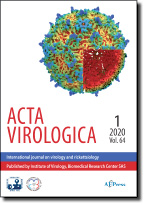Acta Virologica Vol.64, No.3, p.307-324, 2020
|
| Title: Mitochondria-related gene expression profiles in murine fibroblasts and macrophages during later stages of ectromelia virus infection in vitro |
| Author: L. Szulc-Dąbrowska, Z. Wyżewski, K. P. Gregorczyk-Zboroch, F. N. Toka, J. Szczepanowska, J. Struzik, Z. Nowak-Życzyńska, M. Gieryńska, M. Niemiałtowski |
|
Abstract: Mitochondria are multitasking organelles that play a central role in energy production, survival and primary host defense against viral infections. Therefore, viruses target mitochondria dynamics and functions to benefit their replication and morphogenetic processes. We endeavor to understand the role of mitochondria during infection of ectromelia virus (ECTV), hence our investigations on mitochondria-related genes in non-immune (L929 fibroblasts) and immune (RAW 264.7 macrophages) cells. Our results show that during later stages of infection, ECTV significantly decreases the expression of mitochondria-related genes regulating many aspects of mitochondrial physiology and functions, including mitochondrial transport, small molecule transport, membrane polarization and potential, targeting proteins to mitochondria, inner membrane translocation, and apoptosis. Such down-regulation is cell-specific, since macrophages exhibited a more profound down-regulation of mitochondria-related genes compared to infected L929 fibroblasts. Only L929 cells exhibited up-regulation of two important genes responsible for oxidative phosphorylation and subsequent ATP production: Slc25a23 and Slc25a31. Changes in the expression of mitochondria-related genes are accompanied by altered mitochondria morphology and distribution in both types of cells. In depth Ingenuity Pathway Analysis (IPA) identified the “Sirtuin Signaling Pathway” as the most significant top canonical pathway associated with ECTV infection in both analyzed cell types. Taken together, down-regulation of mitochondria-related genes observed especially in macrophages indicates dysfunctional mitochondria, possibly contributing to energy collapse and induction of intrinsic pathway of apoptosis. Meanwhile, alteration of the expression of several mitochondria-related genes in fibroblasts without apoptosis induction may represent poxviral strategy to control cellular energy metabolism for efficient replication.
|
|
| Keywords: ectromelia virus; mitochondria; fibroblasts; macrophages |
|
|
Published online: 10-Aug-2020
|
| Year: 2020, Volume: 64, Issue: 3 |
Page From: 307, Page To: 324 |
doi:10.4149/av_2020_305
|
|
 download file download file |
|
|
|
|
 download file
download file
